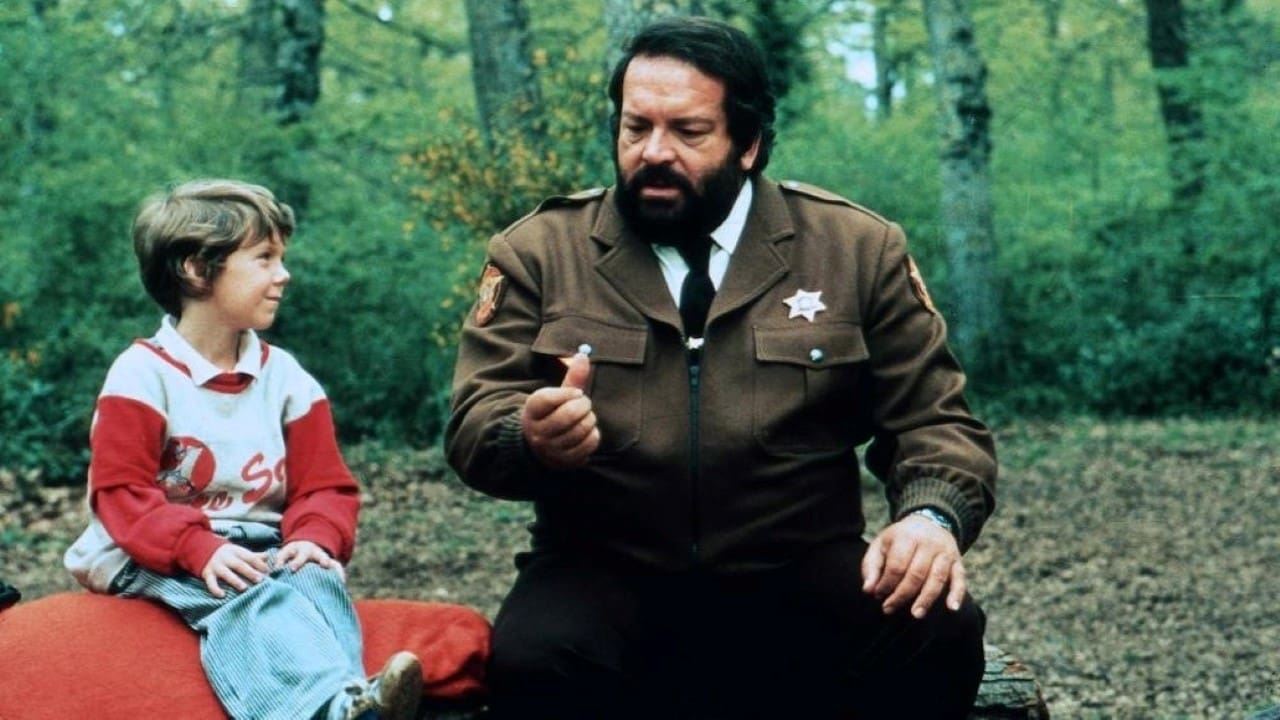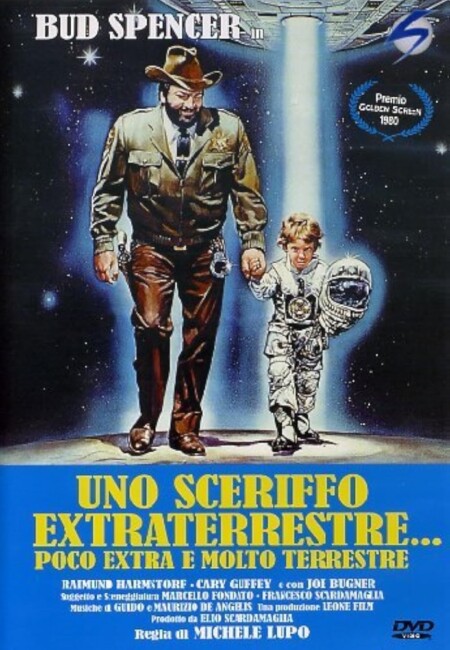(Uno Sceriffo Extraterrestre … Poco Extra e Molto Terrestre)
Crew
Director – Michele Lupo, Screenplay – Marcello Fondato & Francesco Scardamaglia, Producer – Elio Scardamaglia, Photography – Franco Di Giacomo, Music – Guido De Angelis & Maurizio De Angelis, Special Effects – Studio 4, Art Direction – Francesco Vanorio. Production Company – Leone Film.
Cast
Bud Spencer (Sheriff Hall), Cary Guffey (H725), Raimund Harmstorf (Captain Briggs), Joe Bugner (Brennan), Gigi Bonos (Deputy Allen), Harold E. Finch (General Donaldson)
Plot
The people of the town of Newnan, Georgia are in a panic with reports of a UFO in the area. Sheriff Hall comes across a strange kid who claims that his name is H725 and seems to have no home or parents. As he accompanies Hall, H725 demonstrates many amazing abilities with his photonic ray device, including being able to remotely operate any type of equipment, talk to animals and cause people to speed up and reverse their movements. At the same time, an Air Force captain comes determined to capture H725.
Bud Spencer and Terence Hill are two largely forgotten names of 1970s cinema. These are the English-language screen names of the Italian actors known to their mothers as respectively Carlo Pedersoli and Mario Girotti. The two were first paired together in the Western comedy God Forgives … I Don’t (1967). The most famous of their efforts was the Western comedy They Call Me Trinity (1970), which made their names internationally. They made a further seventeen films together up until around the mid-1980s, plus a couple of reunions. Their films included I’m for the Hippopotamus (1979), Who Finds a Friend Finds a Treasure (1981), Double Trouble (1984) and Miami Supercops (1985).
The Bud Spencer-Terence Hill comedies increasingly became pitched down to children’s or undemanding audiences, being driven by a lot of slapstick clonks that usually involved them beating people up. I have memories of them as a kid – what used to be of considerable amusement was the atrocious English dubbing, which became its own in-joke. (One of the pluses in The Sheriff and the Satellite Kid is that the dubbing of Spencer’s voice is at least well coordinated to his lip movements and without any glaring lags).
The late Perdersoli/Spencer, the big burly one of the duo, made ten films on his own without Hill, one of which was The Sheriff and the Satellite Kid. This (and its sequel) was the only of two genre entries that Spencer made alongside Aladdin (1986) in which he played the genie, although Hill did go on to appear in the solo film Super Fuzz (1980) wherein he gains superpowers.
The Sheriff and the Satellite Kid was an attempt to jump aboard the late 1970s science-fiction boom that had been created by Star Wars (1977). The Italians made several cheap Star Wars copies. Less well-remembered among the 70s sf boom these days was Steven Spielberg’s Close Encounters of the Third Kind (1977), even though it was almost as big as Star Wars back in the day. The Sheriff and the Satellite Kid draws from Close Encounters‘ story of alien contact – although, if anything, it looks forward more to Spielberg’s E.T. – The Extra-Terrestrial (1982), which came along three years later. The Close Encounters connection is confirmed by the casting of Cary Guffey, the first of Spielberg’s kid performers, as the alien. Only seven years old at the time, Guffey played in five other films between 1977 and 1985 and has not been heard from since.

The Sheriff and the Satellite Kid is Close Encounters writ down to the level of a typical Bud Spencer-Terence Hill slapstick comedy. The actual UFO contact aspect is minimised no doubt due to budget – we see nothing of the UFO the townspeople are reacting to at the start and get only a couple of brief model shots at the end. Rather what we have is more along the lines of Disney’s Escape to Witch Mountain (1975) and Return from Witch Mountain (1978) in which two alien kids appear and use their psychic powers to play mischief with their human pursuers. Cary Guffey has a magic all-purpose alien device here rather than psychic powers but the net effect is the same.
Thus as Cary Guffey passes through the town, he causes an ice cream vendor’s machine to gush ice cream all over the street and a barber’s chair to spin around. Scenes in the police station involve a coffee machine, a washing machine, a typewriter and a piano starting up of their own accord. Cary Guffey causes aging deputy Gigi Bonos to dance a jig on his desk. A horse comes over and talks to Guffey and Bud Spencer in a voice that sounds like someone who smokes five packs a day. This is the sort of film where people getting punched out is accompanied by tweeting effects on the soundtrack. Some of the most witless scenes are those involving the pursuing military where we have several minutes of shots of helicopters landing and soldiers jumping out that are played in forward motion followed by reverse and then forward again.
Bud Spencer (sometimes joined by heavyweight boxing champion Joe Bugner) engages in plentiful fights – including one that manages to demolish most of a supermarket. The climatic scene involves an all-out punch-up at a market hall with slapstick gags such as where knocked-out soldiers fall into a See No Evil, Hear No Evil line-up, Spencer punching people that spin backwards up a fireman’s pole and a portrait that comes to life to deliver a few punches of its own.
Bud Spencer, Cary Guffey and director Michele Lupo returned for a sequel Everything Happens to Me/Why Did You Pick on Me? (1980).


